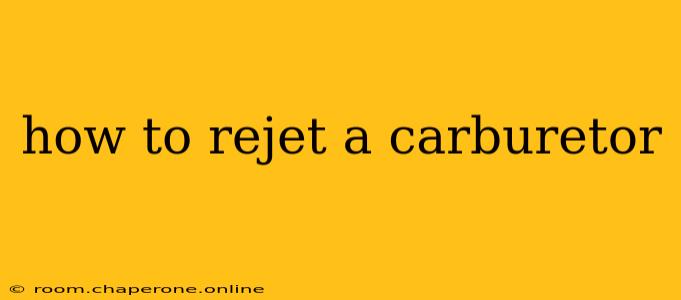Rejetting a carburetor is a crucial step for optimizing your engine's performance, especially after modifications like air filter upgrades or exhaust changes. Getting it right ensures optimal fuel delivery, leading to improved power, throttle response, and fuel efficiency. However, it's a process that requires patience, precision, and a good understanding of your engine and carburetor. This guide will walk you through the entire process.
Understanding Carburetor Jetting
Before diving into the process, let's clarify what jetting actually means. A carburetor uses jets—small orifices—to meter the flow of fuel into the engine. These jets are sized to match the engine's specific needs at various operating conditions. If your engine's air-fuel mixture is too lean (too much air, not enough fuel), you'll experience poor performance and potentially damage the engine. Conversely, a rich mixture (too much fuel, not enough air) leads to poor fuel economy and potentially fouling spark plugs. Rejetting involves changing the size of these jets to correct the air-fuel ratio.
Identifying Your Carburetor's Needs
The need for rejetting often arises from modifications. Here are common scenarios:
-
Air Filter Upgrade: A high-flow air filter allows more air into the engine. Without a corresponding increase in fuel, the mixture becomes lean. This requires increasing the jet size (larger number).
-
Exhaust Modification: A free-flowing exhaust system also improves airflow, similarly requiring a richer mixture and thus a larger jet size.
-
Altitude Changes: At higher altitudes, the air is thinner, demanding a richer mixture to compensate. This usually involves increasing the jet size.
-
Engine Modifications: Changes to the engine's internal components (camshaft, pistons, etc.) significantly impact air-fuel requirements. This may require rejetting, often needing specialized knowledge and possibly professional assistance.
Determining if Rejetting is Necessary: Symptoms of incorrect jetting include:
- Poor acceleration: Sluggish response to the throttle.
- Poor fuel economy: Excessive fuel consumption.
- Rough idling: Unstable engine speed at idle.
- Backfiring: Unburnt fuel igniting in the exhaust system.
- Engine hesitation: Stuttering or stumbling during acceleration.
Tools and Materials You'll Need
Before you start, gather the necessary tools:
- Appropriate sized jet kit: This is specific to your carburetor model; purchase the correct kit based on your engine and modifications.
- Screwdrivers (Phillips and flathead): For removing carburetor screws.
- Socket wrench set: May be necessary depending on carburetor mounting.
- Needle-nose pliers: For handling small parts.
- Fuel-resistant gloves: To protect your hands.
- Clean work area: Essential for preventing dirt or debris from entering the carburetor.
- Shop rags or paper towels: For cleaning.
- Carburetor cleaning solvent (optional): To clean internal parts.
The Rejetting Process
The following steps are a general guideline; always consult your carburetor's specific instructions and the manufacturer's specifications for your engine and jet kit.
1. Preparation: Disconnect the fuel line and battery. Carefully remove the carburetor from the engine, taking note of its position and any connecting lines or linkages.
2. Disassembly (if necessary): Depending on your carburetor, you may need to disassemble it partially to access the jets. Be mindful of small parts and their precise locations. Take pictures if needed.
3. Jet Replacement: Carefully remove the old jets and install the new ones. Make sure they are seated correctly and securely tightened. Refer to the jet kit instructions for correct jet sizing and placement.
4. Reassembly: Carefully reassemble the carburetor, ensuring everything is correctly placed. Double-check that all screws are tightened securely.
5. Reinstallation: Mount the carburetor back onto the engine, ensuring it's properly aligned and all linkages are reconnected.
6. Fuel Line Reconnection and Testing: Reconnect the fuel line and battery. Start the engine and observe its performance. If adjustments are still needed, you may need to experiment with different jet sizes.
7. Fine-Tuning (If Necessary): You may need to further adjust the carburetor's idle mixture screw and air/fuel mixture screws to fine-tune the engine's performance. This is often done using a tachometer and a wide-band air/fuel ratio gauge.
Safety Precautions
- Always work in a well-ventilated area, as carburetor cleaner fumes can be harmful.
- Dispose of used cleaning solvents responsibly, according to local regulations.
- If you're not comfortable performing this task, consult a qualified mechanic. Incorrect jetting can damage your engine.
This comprehensive guide offers a starting point for rejetting your carburetor. Remember, the specifics will vary based on your engine type, carburetor model, and modifications. Always consult your carburetor's service manual and your engine's specifications for accurate guidance. If you're unsure about any step, seeking professional help is always the safest option.

